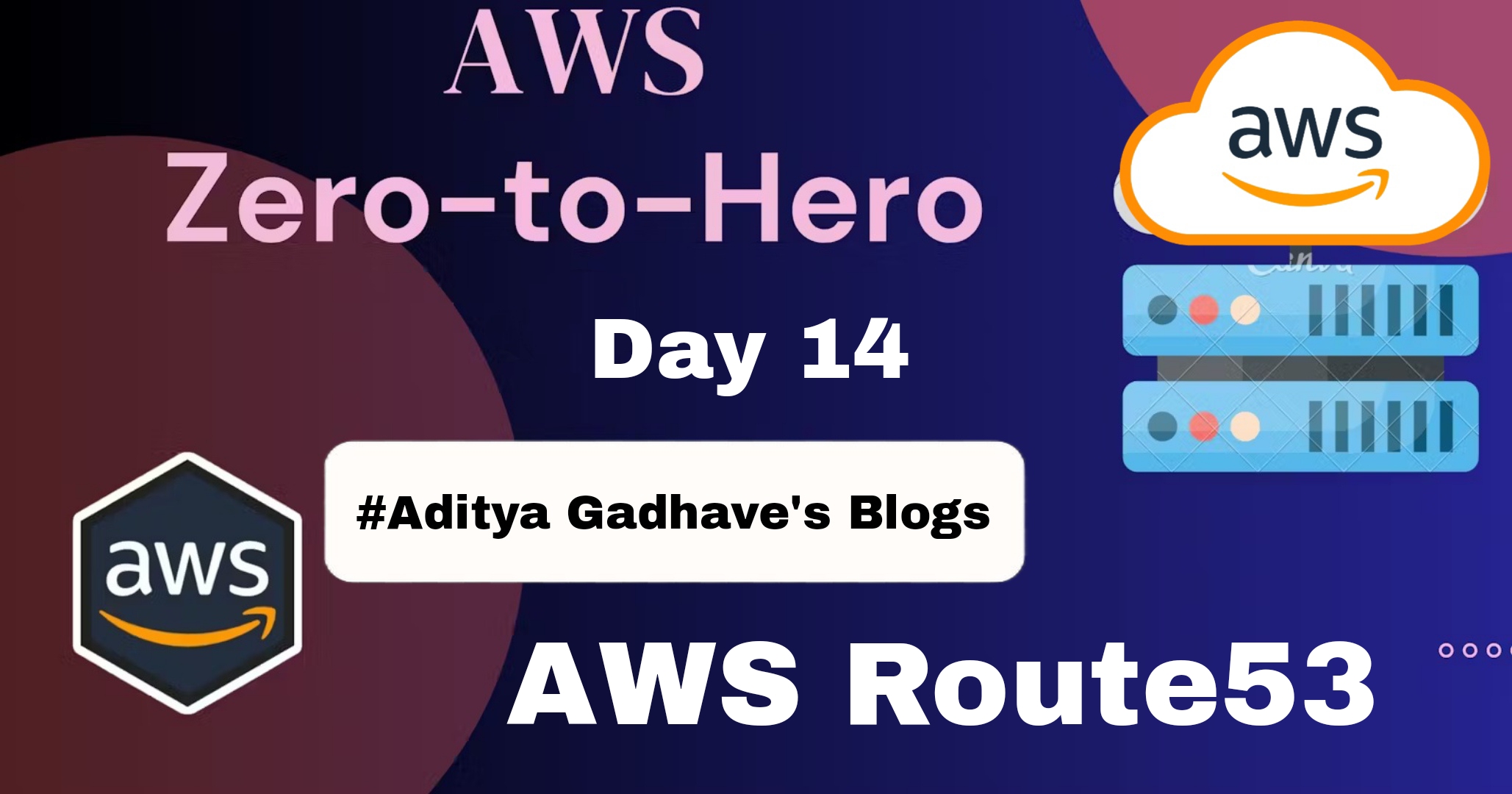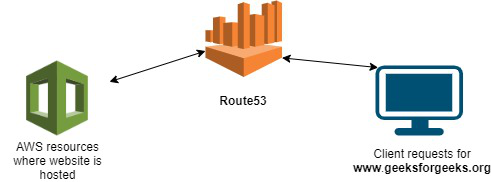Understanding Amazon Route 53: A Comprehensive Guide
 Aditya Gadhave
Aditya Gadhave
What Is Amazon Route 53?
Amazon Route 53 is a highly available and scalable cloud Domain Name System (DNS) web service.
It is designed for developers and corporations to route the end users to Internet applications by translating human-readable names like www.adityagadhave.atwebpages.com into the numeric IP addresses like 192.0.1.1 that computers use to connect.
You cannot use Amazon Route 53 to connect your on-premises network with AWS Cloud.

How Does Amazon Route53 Works?
Amazon Route53 is an aws service than offers a DNS (Domain Name System) web service which is scalable and high available. It is essential for conversion of user friendly domain names into IP addresses so that internet communication can proceed without difficulties. The following are the some of the main features explaining on how Amazon Route 53 functions well:
Domain Registration And Management: Amazon Route 53 allows users to register and maintain domain names through its user-friendly interface. Users can transfer their existing domain to the Route 53 service or can go for register a new one. Users may freely configure the DNS settings, including mail server setups (MX records), domain name aliases , and more, once they have registered.
Global DNS Resolution: Route 53 uses a worldwidet network cast made up of many DNS servers that have been placed strategically all over the world. The IP address which matches to a domain name entered by a user in their web browser is sent back by Route 53’s DNS servers. Users can immediately access the websites and services from anywhere in the globe because of Route 53’s low latency and high-performance DNS resolution by using global network.
Traffic Routing And Load Balancing: Users can set up load balancing and fallback setups for their applications with Route 53’s wide traffic routing capabilities. Users may distribute incoming traffic among several endpoints, such as Amazon EC2 instances, Elastic Load Balancers, or by other external resources, by utilizing capabilities like DNS-based latency routing and weighted round-robin routing.
Functions Of Route53
If a web application requires a domain name, Route53 service helps to register the name for the website (i.e domain name).
Whenever a user enters the domain name, Route53 helps to connect the user to the website.
If any failure is detected at any level, it automatically routes the user to a healthy resource.
Amazon Route 53 is cost effective, secure and scalable.
Amazon Route 53 is flexible, highly available and reliable.
Methodologies Related To Route53
Records: Records are created to route internet traffic to the resources. They are the objects present in the hosted zone which determines how the internet traffic has to be routed for a domain name so that it finally reaches the resources. The name of each record in a hosted zone must end with the name of the hosted zone.
Hosted zone: When the domain name is registered, Route53 creates a public hosted zone that has the same name as the domain name. It is a collection of records that contains information about how to route traffic of its domains and all of its subdomains.
DNS query: It is a request for information sent from DNS client to the DNS server.
Alias records: Alias records helps in routing internet traffic to AWS resources like S3 bucket, Amazon CloudFront, etc. It is created at the top node of the DNS namespace.
Name servers: They are the servers in the DNS that translates the domain name into IP address so that internet traffic can be routed to the resources.
DNS failover: A method for routing the traffic from unhealthy resources to healthy resources, whenever a failure is detected.
Routing policy: Routing policy determines how Amazon Route53 responds to queries.
Benefits And Features Of Route53
Highly Reliable: Route53 is built using AWS’s highly available and reliable infrastructure. The distributed nature of the AWS DNS servers helps ensure a consistent ability to route the end-users to the web application.
Scalable: It automatically scales the resources during large traffic and also handles large queries without the user’s intervention.
Easy To Use: Very user-friendly and easy to configure DNS settings. It can start to answer your DNS queries within minutes. Can be mapped easily to any resource.
Health Check: Route 53 monitors the health of the application. If any failure is detected, it automatically redirects the user to a healthy resource before the customer can identify the problem.
Flexible: You can decide which policy you want to use at given time.
Simple: Using routing types, Route53 helps to manage traffic globally.
Cost-Effective: Payment is done only according to the services used**.**
Secure: By integrating it with IAM, the access to Amazon Route53 is secured by giving its permissions to only the authorized users.
Mapped With Various AWS Services: It can be used to map domain names to Amazon EC2 instances, S3 buckets, and other AWS resources.
Use Cases Of Amazon Route 53
The following are the use cases of Amazon Route 53:
High Availability And Reliability: Route 53 is designed for facilitating highly available and reliable DNS (Domain Name System ) service. It uses global distribution network of DNS Servers for ensuring fast and accurate resolutions of DNS queries.
Scalability: Whenever the traffic grows up, the Route53 service scales seamlessly in handling millions of DNS queries per second, without looking any intervention required on your part. This lets the users to access the applications or websites even during the high period of demands.
Traffic Management: Route53 provides the traffic management features that facilitates the route end users to most of the appropriate resources that are based on factors such as geographic locations, latency, health checks and routing policies.
Health Checks And Failures: Route53 supports in monitoring the health of the application endpoints and helps in automatically rerouting the traffic to healthy endpoints in case of failures or degraded performance.
Integration With Other AWS Services: Route53 facilitates with seamless integration with other AWS services such as Amazon S3, Elastic Load Balancing and Amazon CloudFront allows to easily route the traffic to these services and increase the capabilities for scalable architectures.
How To Configure Amazon Route 53 In AWS ?
AWS Route53 is a highly available DNS service and scalale service, it working model is as shown below.
Let’s take an example, client accessed some site URL www.mysite.in in the browser
End user requests the URL in the browser
DNS Resolver resolves the domain
ROute53 returns the IP Address for the record
From the IP address received browser will show the User interface
Conclusion:
In conclusion, Amazon Route 53 is a highly reliable and scalable Domain Name System (DNS) web service that plays a crucial role in managing and routing internet traffic to applications hosted on AWS. Its integration with AWS services, coupled with advanced traffic management features like latency-based routing, geolocation routing, and health checks, makes it a robust solution for improving the availability and performance of applications.
If you have any questions, need clarifications, or want to discuss anything related to AWS technologies, feel free to reach out to me on LinkedIn. Connect with me at Aditya Gadhave, and I'll be more than happy to assist you. 😊
Subscribe to my newsletter
Read articles from Aditya Gadhave directly inside your inbox. Subscribe to the newsletter, and don't miss out.
Written by

Aditya Gadhave
Aditya Gadhave
👋 Hello! I'm Aditya Gadhave, an enthusiastic Computer Engineering Undergraduate Student. My passion for technology has led me on an exciting journey where I'm honing my skills and making meaningful contributions.